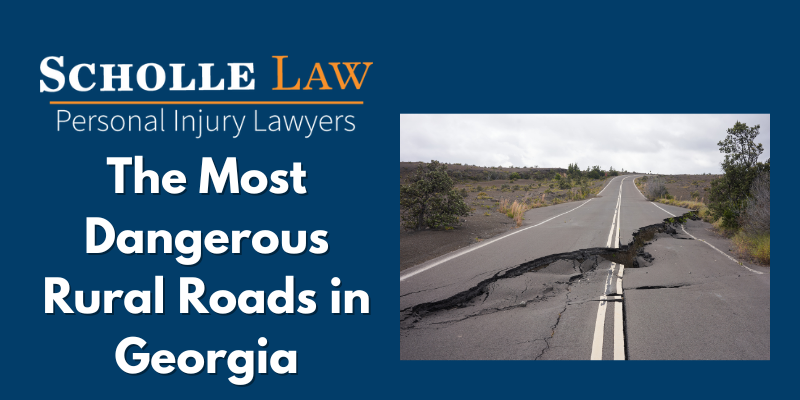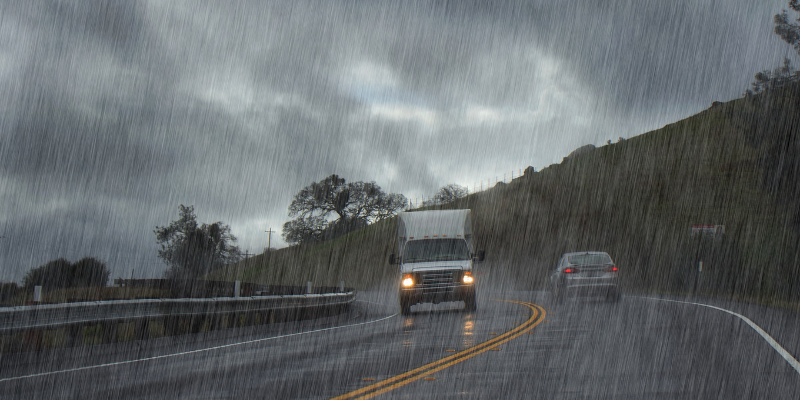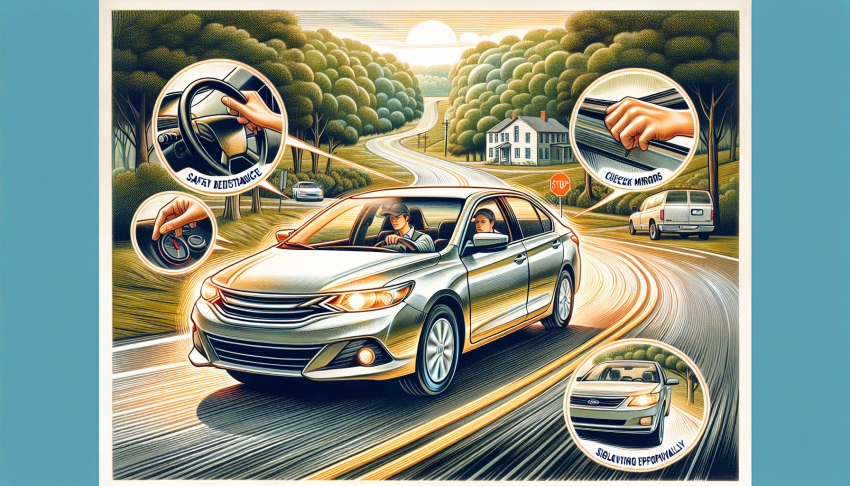4.9 Rating
Google REVIEWS
Leaders in Georgia Personal Injury Law Since 1995
Traversing Danger: A Guide to the Most Dangerous Rural Roads in Georgia
Are you wary of some of the most dangerous rural roads in Georgia, known for their high accident rates and wondering which paths to avoid or traverse with extra caution? You’re not alone. Many seek to understand why certain roads in the Peach State have earned the grim distinction of being most dangerous. Our comprehensive guide identifies these notorious rural roads, explores contributing factors to their peril, and provides critical tips for those who must navigate them.

Key Takeaways
- Georgia’s rural roads, particularly near Atlanta, are marked by high fatality rates, with specific highways like I-285 in East Point being notably dangerous due to a high volume of fatal crashes.
- Drunk and distracted driving significantly contribute to the rising number of fatal accidents on Georgia’s rural roads, leading to severe economic and emotional impacts on local communities.
- Governor Brian P. Kemp has allocated $277 million for rural road improvements in Georgia, and initiatives by the Georgia Department of Transportation (GDOT) and community advocacy are essential for enhancing road safety and reducing accident risks.

Unveiling Georgia’s Riskiest Rural Routes
The serene backdrop of Georgia’s countryside belies the grim reality of its rural roads, where danger often lurks around each bend. Nestled within this picturesque setting are concentrated stretches that have become infamous for their high fatality rates. With a staggering 427 fatal crashes occurring on just 57 road segments, spanning 277 miles, these areas are a stark reminder of the risks that come with driving in rural Georgia.
Most notably, the vicinity of the largest city, Atlanta, emerges as a regional cluster of high-risk areas, illuminating a pressing need for heightened safety measures on these dangerous highways.
Identifying the Perilous Paths
A recent study by MoneyGeek sheds light on the most dangerous roads that slice through the Atlanta metro area, drawing upon a wealth of data from the National Highway Traffic Safety Administration. The most dangerous interstate of I-285 in East Point stands out, notorious not just for the volume of fatal crashes but for the haunting regularity with which they occur. These perilous paths, including the deadly roads of the Atlanta metro area, were pinpointed by considering stretches with at least five fatal crashes within a mere 2.5-mile radius.
This methodical approach has brought into focus the following highways and routes that demand our unwavering attention and urgent action to mitigate the dangers they pose.
The Role of Weather and Visibility in Rural Road Safety
As any seasoned Georgian driver knows, the whims of weather can turn a familiar road into a treacherous journey. On rural stretches, where the infrastructure often lacks the sophistication of urban counterparts, the caprices of nature necessitate a more cautious approach to driving. Inclement weather demands that drivers increase their following distance and decrease their speed to maintain a grip on safety.
This is particularly true on the dangerous highways that crisscross Georgia’s countryside, where a sudden fog or a downpour can obscure visibility and transform the road into a hazardous obstacle course.
Infrastructure and Maintenance Concerns
The very fabric of Georgia’s rural roads, the infrastructure that underpins every journey, often hides its flaws until it is too late. Recognizing and addressing these infrastructure problem areas is vital for targeted safety improvements on dangerous rural highways.
The challenges faced by emergency responders in these regions are compounded by limitations in infrastructure, resources, and training. As the Traffic Safety Research and Evaluation Group delves into the nuances of these roads through the Healthier Together program, their findings will inform enhancements that could one day turn these deadly roads into safer passages for all.
Fatal Crashes and Their Aftermath in Rural Georgia
Over the past decade, Georgia has been gripped by a troubling uptick in traffic fatalities, a trend that casts a long shadow across its beautiful landscapes. From 2012 to 2021, the state witnessed a heart-wrenching total of 14,516 deaths resulting from automobile accidents. And while the Atlanta area continues to grapple with its notorious stretches, rural counties have borne a disproportionate impact, with a third of all roadway deaths occurring in these less urbanized regions in 2020.
This disturbing reality underscores:
- The growing danger on rural roads
- The mounting toll on communities that sprawl in these areas
- An alarming increase in severe injuries despite expectations for a pandemic-induced decline.

Drunk Driving and Distracted Driving: Deadly Behaviors
Peering into the causes of these tragedies reveals a tapestry of deadly behaviors that have no place on our roads. Drunk driving, the scourge of safe travel, has been linked to 20 percent of the fatalities analyzed on Georgia roads. And while the dangers of driving under the influence are well known, the silent epidemic of distracted driving is just as lethal, with at least a third of drivers potentially succumbing to the lure of their phones.
These behaviors, alongside speeding, lack of seatbelt usage, and increased substance use, form a deadly cocktail that has fueled the rise in fatal accidents, including the occasional fatal accident, on the dangerous roads of Georgia.
Consequences for the Local Community
The repercussions of these fatal crashes reverberate far beyond the asphalt and the shattered glass. Economically, the impact is staggering, with car accidents in Georgia costing over $10 billion annually. Families are burdened with medical expenses, lost wages, and the heartache that comes with long-term care or permanent loss.
The ripple effects of these tragedies on productivity and property damage only compound the profound economic and emotional toll on local communities.

The Most Dangerous Highways: Spotlight on Specific Dangerous Roads
As we zoom in on the Georgia highway map, certain routes stand out for their notorious reputation. Some of the most dangerous roads in Georgia include:
- Moreland Avenue, with its stretch from South River Industrial Boulevard to Wylie Street, which has been grimly christened the most fatal road in Georgia.
- Interstate 20, particularly between Panola Road and Candler Road, is another high-risk area that demands attention, with 10 to 13 deaths haunting this major east-west highway during the study period.
- S. Route 78 in the Atlanta metro area, known for its sharp curves.
These most dangerous highways pose significant risks to drivers and require extra caution.
Even beyond the Atlanta metro area, rural roads near Augusta and Savannah, such as Mike Padgett Highway and Interstate 516, have recorded significant fatality rates, painting a harrowing picture of the risks that drivers face across the state.
Narrow Lanes and Sharp Curves: A Recipe for Danger
The design of a road can be its most silent hazard. In Georgia, narrow lanes and sharp curves are often the unseen culprits behind many motor vehicle accidents. The Stone Mountain Freeway (U.S. Route 78), notorious for its hazardous combination of heavy traffic, high speeds, and sharp curves, serves as a cautionary example of how structural elements can heighten the danger on rural roads. One such example is the Riverdale Road exit, where the design contributes to the risk of motor vehicle accidents.
These deadliest stretches, like Moreland Avenue, expose drivers to an increased risk of accidents, especially when these structural challenges are compounded by distracted or drunk driving.
The Isolation Factor: Response Times and Rescue Challenges
In the aftermath of an accident on a rural road, every second counts. Yet, the very isolation that defines these areas can be a barrier to survival, with outdated infrastructure and challenging terrain delaying emergency responders. Ambulances struggle to navigate the labyrinthine routes to reach the injured, and at times, helicopter medevac becomes the only lifeline connecting crash victims to the urgent care they need.
In the mountainous terrain of northern Georgia, these challenges are amplified, with response times significantly longer than in urban areas, increasing the likelihood of a fatal outcome.
Staying Safe on Georgia’s Rural Roads: Tips and Strategies
Navigating Georgia’s rural roads with awareness and preparation can make all the difference between a safe journey and a tragic one. Here are some tips to help you stay safe on rural roads:
- Plan your route in advance
- Adjust to traffic conditions
- Allow extra travel time
- Avoid the impulse to speed
- Reduce the risk of accidents
By following these tips, you can have a safer journey on rural roads.
By abiding by Georgia’s hands-free law and following safe driving practices, drivers can stay safe and ensure that the scenic drive doesn’t turn into a deadly one.

Defensive Driving: Anticipating the Unexpected
Defensive driving is not just a skill—it’s a mindset that can save lives on Georgia’s dangerous roads. Vigilance at intersections and a healthy distance between vehicles can mitigate the risk of accidents. Maintaining calmness and respecting other drivers can help prevent the escalation of situations that could lead to an accident.
By anticipating the unexpected and preparing for the actions of other drivers, one can navigate these perilous paths with greater assurance.
Vehicle Readiness: Ensuring Safe Travels
The condition of your vehicle plays a crucial role in your safety on the road. Regular maintenance checks, ensuring all lights and signals work, and inspecting tires for proper inflation and tread depth can prevent many mechanical-related accidents.
In the winter months, the use of winter tires can significantly enhance handling and safety on icy or snowy roads. Ensuring that headlights are properly aligned and clean also improves visibility during night driving, a critical factor on rural roads where lighting may be limited.

Legal Recourse for Victims of Rural Road Accidents
Victims of rural road accidents in Georgia have the right to seek legal recourse to cope with the aftermath of a devastating event. With a two-year deadline to file a claim, it is crucial for victims to act promptly to ensure their case is heard.
A thorough investigation is necessary to determine fault and establish liability, and victims have the right to seek financial compensation if another party is at fault.
Gathering Evidence: Building a Strong Case
In the event of an accident, gathering evidence is a critical step in building a strong case. Here are some types of evidence that can be invaluable in legal proceedings:
- Photos of the scene
- Photos of vehicle damage
- Photos of injuries
- Witness contact details
- Official police reports
- Medical documentation of injuries
These pieces of evidence will play a significant role in the investigation and can help victims establish their damages and maximize their recovery.
Seeking Representation: The Importance of Experienced Legal Advice
Navigating the insurance claims process can be daunting, but with the expertise of seasoned car accident lawyers, victims can challenge low-ball offers and ensure they receive fair compensation. At Scholle Law, our attorneys have decades of experience in providing specialized legal advice and representation, whether it be in settlement negotiations or in court, to help victims gather the necessary evidence and maximize their recovery.
Designing Safer Rural Roads: Initiatives and Improvements
The quest for safer rural roads in Georgia is ongoing, with initiatives and improvement projects aimed at reducing the risk of accidents. Governor Brian P. Kemp’s announcement of a $277 million funding allocation to the Georgia Department of Transportation underscores the importance placed on enhancing safety and reliability on rural roads.
These funds, part of the Coronavirus Response and Relief Supplemental Appropriations Act 2021, will expedite construction projects and bring about strategic transportation improvements across several Georgia counties.
Governmental Efforts: GDOT’s Role in Enhancing Safety
The Georgia Department of Transportation (GDOT) is at the forefront of this mission, actively working on road improvement projects that will not only enhance safety but also improve traffic efficiency on rural roads. With projects ranging from expanding highways to constructing bypasses around congested areas, GDOT is utilizing the supplemental funds from the COVID response to pave the way for a safer future.
Among these initiatives, the installation of barriers on I-16 near the Camp Creek Parkway interchange is a notable effort to reduce accident risks and protect the lives of those who travel these roads.
Community Involvement: How Residents Can Make a Difference
While GDOT steers the larger infrastructure projects, the role of local communities in advocating for safer roads cannot be overstated. Community leaders from counties such as Jefferson and Upson have rallied behind transportation improvement projects, understanding their critical role in not only safeguarding residents but also in fostering regional economic growth.
When residents and community leaders join forces, their collective voice becomes a powerful catalyst for change, pushing for road safety enhancements that reflect the needs and concerns of those most affected by the dangers of rural highways.
Summary
Traversing Georgia’s rural roads can be as breathtaking as it is perilous. This journey through the state’s most dangerous roads has illuminated the multifaceted nature of rural road safety, from identifying high-risk areas and understanding the causes of fatal crashes to spotlighting specific hazardous highways and learning how to stay safe. It has also highlighted the importance of legal recourse for accident victims and the collective efforts to design safer roads. We hope this guide leadings to more informed drivers, safer travels, and a united front in the campaign for road safety in Georgia.
Frequently Asked Questions
What is considered the most dangerous road in Georgia?
The most dangerous road in Georgia is Moreland Avenue from South River Industrial Boulevard to Wylie Street, which has a high number of fatal incidents.
How does weather affect driving on rural roads in Georgia?
In conclusion, weather conditions necessitate adjusting driving behavior by increasing following distance and reducing speed for better control and visibility on rural roads in Georgia.
What causes the majority of fatal crashes on Georgia's rural roads?
The majority of fatal crashes on Georgia’s rural roads are caused by drunk driving, distracted driving, speeding, lack of seatbelt usage, and increased substance use. These factors are major contributors to the accidents.
How can I ensure my vehicle is ready for travel on rural roads?
To ensure your vehicle is ready for travel on rural roads, conduct regular maintenance checks, verify lights and signals, inspect tires, use winter tires, and ensure headlights are properly aligned for enhanced safety.
What legal rights do accident victims have in Georgia?
Accident victims in Georgia have the right to seek financial compensation if another party is at fault. It is important to gather evidence, seek legal representation from Scholle Law, and file a claim within two years of the accident.
